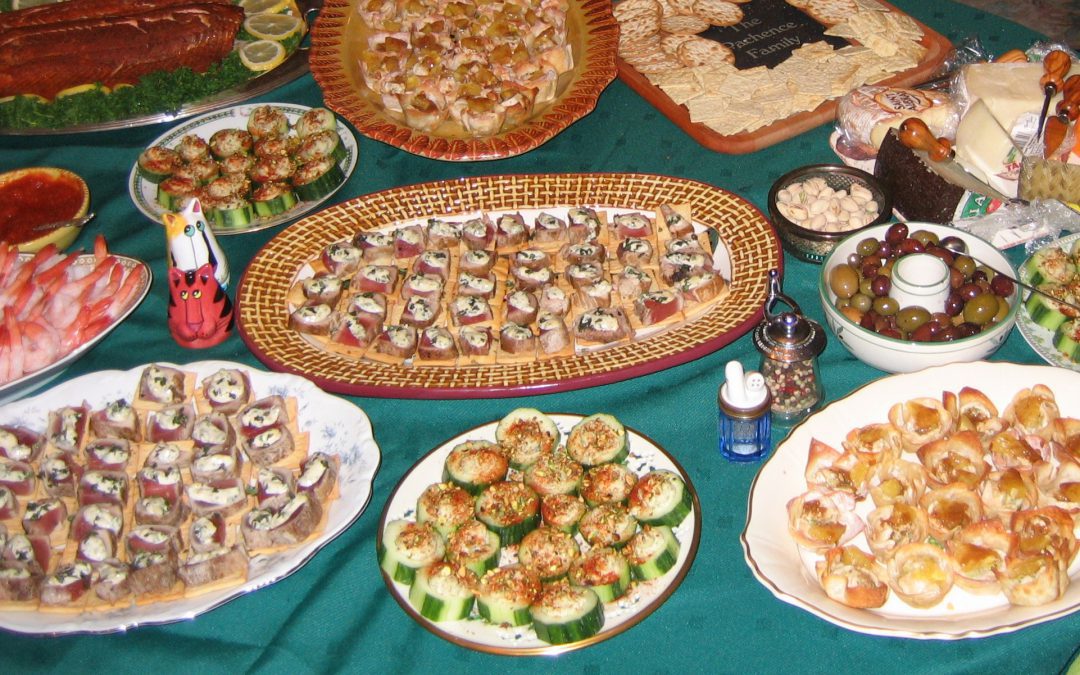There are many Italian Americans, or folks who wish they had Italian heritage, who celebrate The Feast of the Fishes on Christmas Eve. The tradition seems to have its roots in central and southern Italian tradition, but is found anywhere that fish is plentiful in Italy.
The long tradition of eating seafood on Christmas Eve has its roots in from the Roman Catholic faith, as a form of abstinence; Catholics were to refrain from eating meat or dairy on certain holy days, including Christmas Eve. As no meat or butter could be used on such days, observant Catholics would instead eat seafood, typically fried in oil.
Many of the dishes found on the Feast of the Fishes menu include calamari, eel, clams, mussels, salt cod, and other ingredients which were often considered peasant food (plentiful supply, and inexpensive). Now, most of these ingredients are considered gourmet. In true Italian style, the Feast of the Fishes has turned into course after course of luxurious seafood dishes.
Different regions have their own tradition – and it seems that Italians throughout the world create their own traditions. The number of fishes can be seven (the most common), nine, or eleven, and seafood dish preparations can be wildly different. The number “7” mostly likely also has religious meaning, as seven appears in the Bible over 700 times (Genesis 2:2: “By the seventh day God completed the work he had been doing; so on the seventh day he rested from all his work.” ). There are also seven sacraments. The number “11” is also important to Catholics, often represented by the Twelve Apostles, minus Judas, for example.
We have a family history coming from Northeast Pennsylvania, where we celebrated the Feast of the Seven Fishes in a progressive dinner format – trekking from house to house, often in snow. Fortunately, that was a time when families lived within blocks of one another. There was always calamari, either fried or cooked in a marinara sauce, fried smelts, baccalà (salt cod) with pasta, as a salad or fried, shrimp (scampi, or cocktail), octopus (usually in marinara, or as a salad), marinated eel, clams, and mussels.
Here are a few classic Feast of the Fishes recipes:
Fried Smelts Italiano
Ingredients
- 1 pound smelts, cleaned, patted dry with paper towels
- Flour for dredging – salt, peppered, and seasoned (Italian herb mixture).
- 1 egg beaten with 2 tablespoons milk, plus salt and pepper to taste.
- 2 cups of seasoned bread crumbs
- Canola oil for frying.
- Coarse sea salt
- Lemon wedges
Instructions
- Place flour in gallon or quart size storage bag add fish shake to coat.
- Dip fish into the egg/milk mixture to coat.
- Place the fish into the bread crumb mixture, and shake off the excess (this step can be done the day before, with the fish kept in the refrigerator until frying).
- In a large hot pan or fryer, add the oil to a depth that will cover the fish. Heat the oil to 365 degrees. If you’ve refrigerated the fish, bring to room temperature before frying.
- Fry the fish in batches, making sure that the oil temperature never dips below 350 degrees. The fish will take about 2 – 3 minutes to cook.
- Remove to paper towel or brown paper to drain oil season generously with salt and pepper and garnish if desired with lemon.
Bacala alla Mickalena
Ingredients
- 4 thick pieces of baccala, or a one pound box (found in many Italian specialty stores)
- flour for coating
- 3 to 6 tbs of Olive oil
- 1/2 medium sweet onion, diced
- 1 or 2 chopped garlic cloves, (according to taste)
- 1/2 cup Marsala wine
- 1 cup of chopped tomatoes (we suggest ripe fresh tomatoes, or a premium brand of San Marzano)
- 1/2 cup vegetable broth
- Juice from 1/2 lemon
- Chopped parsley
- pinch of hot pepper (optional)
- 1 ts of capers
- 12 to 15 olives, sliced
- salt and pepper to taste (be careful: bacala can be quite salty).
Instructions
- The baccala should be soaked in water for 2-3 days, changing the water once per day. Some chefs will soak in milk for 1 day. After the baccala has been soaked, rinsed and pat down with paper towel to absorb extra moisture. Cut into pieces about 2 inch square.
- Roll baccala’ pieces in flour and set aside.
- In saute’ pan, heat olive oil. Add baccala’ and saute’ until golden on both sides, about 2 minutes. Place the fish on a screen to drain, and lightly salt.
- After the fish has been sauteed and removed from pan, and add the diced onion to the hot pan (you may need to add more oil).
- Add the chopped garlic. After about 30 seconds (or until you just smell the garlic), add the Marsala wine, and reduce by one half.
- Add the tomatoes, lemon juice, vegetable broth and pinch of hot pepper (if you desire). Cook until it is slightly thick, about 10 minutes.
- Add baccala’ back to the pan plus the rinsed capers and olives.
- Cover and let it simmer for about 10 to 15 minutes, turning baccala’ once.
- Taste and adjust seasonings, if needed (salt and pepper)
- Sprinkle fresh, chopped parsley over the baccala’ before serving.
Linguine with Clams
Ingredients
- 3 tablespoons kosher or coarse sea salt
- 1 pound linguine
- 12 tablespoons extra-virgin olive oil
- 4 cloves garlic, thinly sliced
- 24 Manila or littleneck clams, scrubbed; alternatively, use 1 can of small clams
- Optional: 1 tablespoon plus 1 teaspoon red pepper flakes
- 1 cup dry white wine (preferably Soave or Pinot Grigio)
- 1 (14-ounce) can whole San Marzano tomatoes in juice, juice reserved and tomatoes coarsely chopped
- Salt and pepper to taste
- 1/2 cup plus 2 tablespoons fresh flat-leaf parsley, coarsely chopped
Instructions
- In large sauté pan over moderately high heat, heat 6 tablespoons extra- olive oil until hot but not smoking. Add garlic and sauté until just golden, about 30 seconds. Add clams and 1 tablespoon red pepper flakes (optional) and sauté 1 minute.
- Add wine, tomatoes and juice, and 1/2 cup parsley and simmer, uncovered, just until clams open, 7 to 8 minutes.
- In large pot over moderately high heat, combine 8 quarts of water to boil and salt. Bring to boil, then add linguine and cook to 1 minute short of al dente according to package directions (pasta should still be quite firm). Reserve 1/2 cup cooking water, then drain linguine.
- Add linguine to the sauce pan. Simmer, tossing occasionally, until linguine is just tender, about 1 minute. If necessary, add some of reserved cooking water to keep moist. Remove from heat. Add remaining 2 tablespoons parsley, and extra-virgin olive oil to taste, tossing to coat.


